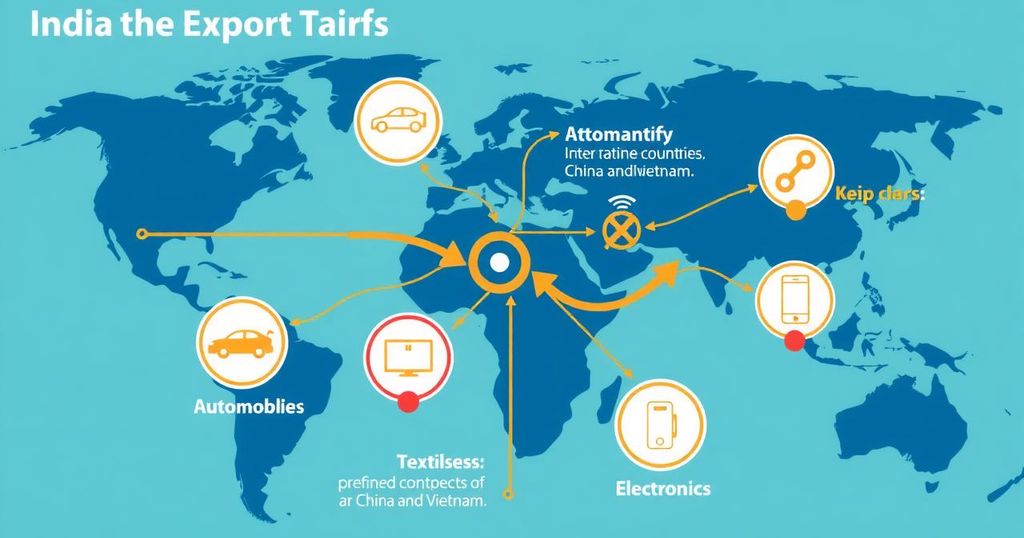Cars
AFRICA, ASIA, AUTOMOTIVE INDUSTRY, BANGLADESH, CAMBODIA, CANADA, CHINA, DONALD TRUMP, EXPORTS, FOREIGN INVESTMENT, HONDA, INDIA, INDONESIA, INTERNATIONAL TRADE, JAGUAR LAND ROVER, MEXICO, NISSAN, NORTH AMERICA, PHILIPPINES, SAUDI ARABIA, SOUTH AFRICA, SRI LANKA, SUPPLY CHAIN, TATA MOTORS, THAILAND, TRADE, UNITED STATES, US, VIETNAM
Fatima Alavi
0 Comments
Impact of US Tariffs on Indian Exports: Gains and Losses for Key Sectors
In 2023, India, with exports worth $441 billion, faces a 27 per cent tariff on exports to the US. While challenging, India is better off compared to rivals like China and Vietnam. Key sectors such as textiles may benefit, whereas automobiles, while adversely affected, contribute minimally to US exports. Ongoing trade discussions could alleviate some tariff pressures.
In 2023, India achieved the milestone of becoming the world’s 12th-largest exporter, with total exports valued at $441 billion. However, the United States has imposed a significant 27 per cent flat tariff on all Indian exports, presenting substantial challenges for local exporters. Nevertheless, in comparison to major rivals such as China, Vietnam, Bangladesh, and Indonesia, India might still maintain a relatively advantageous position.
For instance, China faces a more burdensome 34 per cent tariff, while Vietnam is subjected to a steep 46 per cent tariff. Other countries like Bangladesh and Thailand experience 37 per cent tariffs, with Cambodia receiving the highest at 49 per cent and Sri Lanka at 44 per cent.
The introduction of a 25 per cent tariff on imported automobiles is likely to have severe implications for major Asian automakers, including Toyota, Honda, and Nissan. Indian automobile exports to the US are minimal, comprising merely 0.13 per cent for passenger vehicles and 3 per cent for commercial vehicles. Tata Motors may encounter indirect effects on its premium car segment, Jaguar Land Rover, which derives approximately 23 per cent of its revenue from the US.
While Indian auto component exports to the US constitute one-third of its total exports, they still represent only 2 per cent of the US auto component import market, falling well behind Mexico’s 39 per cent, Canada’s 13 per cent, and China’s 12 per cent. Overall, the US accounted for less than 0.5 per cent of Indian car exports in 2023, with principal export destinations being Saudi Arabia, South Africa, and Mexico.
India’s textile industry stands to gain from the new tariff framework, as its major competitors—Vietnam, Bangladesh, and China—face considerably higher duties. The US import duties are 46 per cent for Vietnam, 37 per cent for Bangladesh, and 34 per cent for China. India commands an 8 per cent share of US textile imports, valued at $9.7 billion, showcasing its competitive edge in this sector despite contributing only 2 per cent to its GDP compared to 11 per cent for Bangladesh and 15 per cent for Vietnam.
As a leading supplier of gems and jewellery to the US, India holds a substantial 12.99 per cent share, valued at $11.58 billion, of total US imports for this category. Competing nations like France, Italy, UAE, and Thailand have notably smaller contributions, further solidifying India’s position, though the new tariffs might impose challenges on exporters.
The new 27 per cent tariff will also impact key agricultural exports such as basmati rice, buffalo meat, and wheat. However, India could still leverage its price advantage in processed food items against competitors like China, Vietnam, Thailand, and Bangladesh. In contrast, Mexico, benefitting from the US-Mexico-Canada Agreement (USMCA), enjoys lower tariffs of 0–5 per cent on compliant agricultural goods, providing a competitive edge in fresh produce and packaged foods.
In the electronics sector, India exports $14 billion to the US, and the imposed 27 per cent tariff will escalate costs for these products. Despite the tariff increase, India remains more favorable in comparison with Vietnam’s 46 per cent and China’s 34 per cent. Even so, Mexico retains a significant advantage due to its tariff-free access under the USMCA for compliant goods, while non-compliant products are subjected to a 25 per cent tariff.
Ongoing discussions around a bilateral trade agreement between India and the US could potentially offer relief from these tariffs. Despite the new trade barriers, India appears better positioned than several competitors, possibly enhancing the competitiveness of Indian exports in certain sectors.
The recent imposition of tariffs by the United States has significantly affected various sectors of the Indian export market. While challenges arise, especially for automobiles and agriculture, certain sectors like textiles and electronics may remain competitive compared to other nations facing higher tariffs. Continuous negotiations for a bilateral trade agreement offer hope for mitigating some of the tariff impacts. Moreover, recognizing strengths in specific industries is crucial for Indian exporters to navigate these new trade dynamics effectively.
Original Source: www.business-standard.com




Post Comment